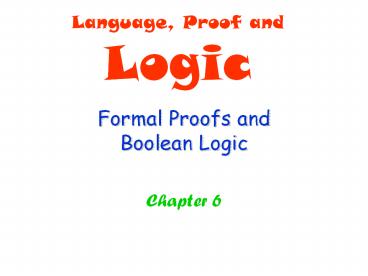Formal%20Proofs%20and%20Boolean%20Logic - PowerPoint PPT Presentation
Title:
Formal%20Proofs%20and%20Boolean%20Logic
Description:
Language, Proof and Logic Formal Proofs and Boolean Logic Chapter 6 Conjunction rules 6.1 Elim: P1 Pi Pn Pi Intro: P1 Pn – PowerPoint PPT presentation
Number of Views:131
Avg rating:3.0/5.0
Title: Formal%20Proofs%20and%20Boolean%20Logic
1
Formal Proofs and Boolean Logic
Language, Proof and Logic
Chapter 6
2
Conjunction rules
6.1
? Intro P1 ? Pn P1??Pn
? Elim P1??Pi??Pn Pi
- A?B?C
- B ? Elim 1
- C ? Elim 1
- C?B ? Intro 3,2
3
Disjunction rules
6.2a
? Elim P1??Pn ? S
? Intro Pi P1??Pi??Pn
P1 S
Pn S
4
Example
6.2b
1. (A?B) ? (C?D) 2. A?B
3. B ? Elim 2
4. B?D ? Intro 3 5. C?D
6. D ? Elim 5 7.
B?D ? Intro 6 8. B?D
? Elim 1, 2-4, 5-7
You try it, page 152
5
Contradiction and negation rules
6.3
? Intro P ?P ?
? Elim ? P
? Intro P ? ?P
? Elim ??P P
You try it, p.163
6
The proper use of subproofs
6.4
A subproof may use any of its own assumptions and
derived sentences, as well as those of its
parent (or grandparent, etc.) proof. However,
once a subproof ends, its statements are
discharged. That is, nothing outside that
subproof (say, in its parent or sibling proof)
can cite anything from within that subproof.
7
Strategy and tactics
6.5
- When looking for a proof, the following would
help - Understand what the sentences are saying.
- Decide whether you think the conclusion follows
from the premises. - If you think it does not follow, look for a
counterexample. - If you think it does follow, try to give an
informal proof first, and - then turn it into a formal one.
- 5. Working backwards is always a good idea.
- 6. When working backwards, though, always check
that your - intermediate goals are consequences of the
available information. -
You try it, page 170.
8
Proofs without premises
6.6
The conclusion of such a proof is always
logically valid!
1. P??P 2. P ? Elim 1
3. ?P ? Elim 1 4. ?
? Intro 2,3 5. ?(P??P) ? Intro
1-4

